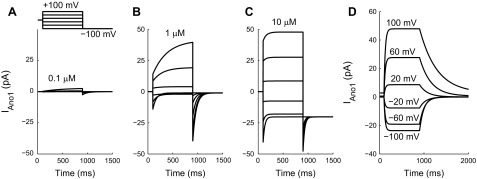Fig. 3.

A–C: simulated voltage-clamp experiments to test the response of the Ano1 model to the voltage protocol used by Xiao et al. (see Fig. 1, A–E, in Ref. 70). From a holding potential of 0 mV, the Ano1 model was stepped for 800 ms to a Vm between −100 and +100 mV in 40-mV increments, followed by a hyperpolarizing step to −100 mV, as shown in the inset. Depolarizing steps activate Ano1 currents more strongly and rapidly at higher Ca2+ concentrations, as expected. However, above 1 μM Ca2+ the decay of the simulated tail currents following a hyperpolarizing step occurs more rapidly than expected based on experimental observations. D: simulated rapid Ca2+ perfusion experiments, to compare the response of the Ano1 model to published rapid perfusion experiments (see Fig. 3, A and B, in Ref. 70). Vm in the Ano1 model was set at a fixed holding potential ranging from −100 to +100 mV and CaAno1 was stepped from 0.1 to 20 μM for 800 ms. Ano1 activation upon application of 20 μM Ca2+ occurs quickly and the rate of activation is only weakly voltage-dependent, while deactivation upon removal of 20 μM Ca2+ is slow and the deactivation rate is strongly voltage dependent.
